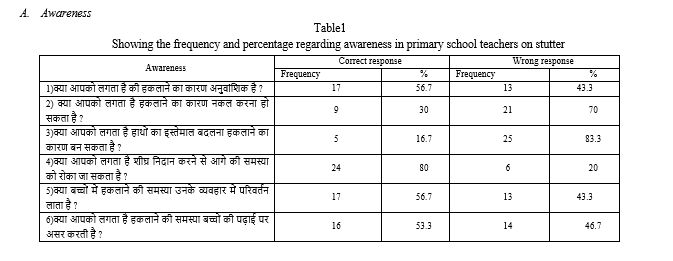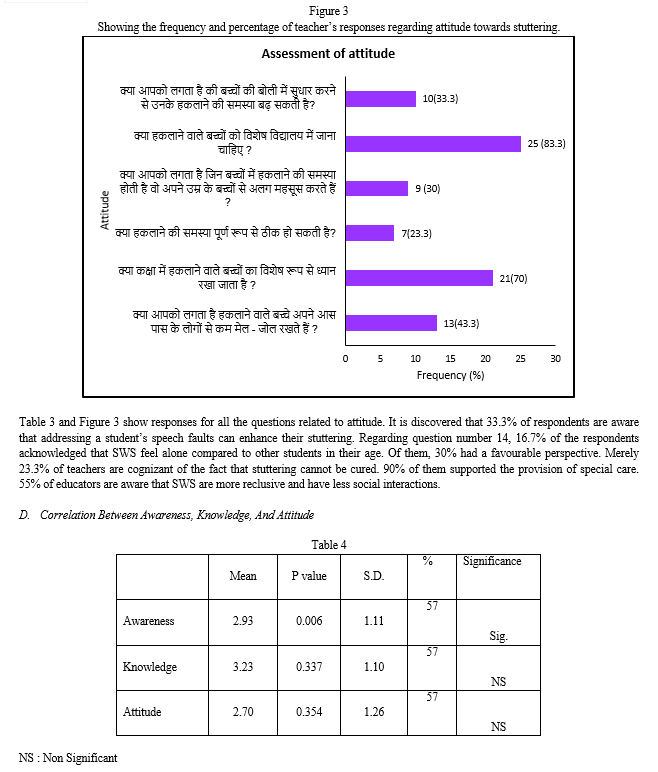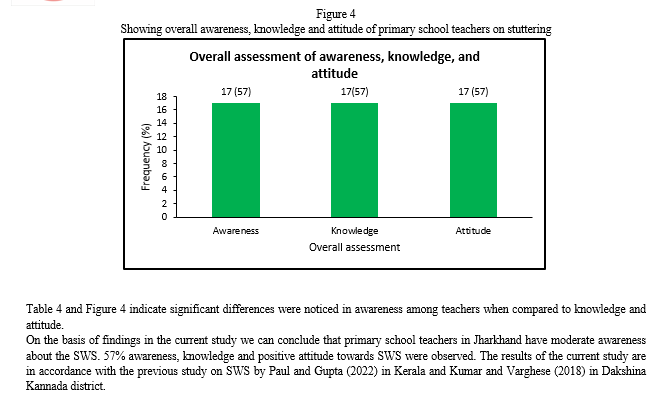Ijraset Journal For Research in Applied Science and Engineering Technology
- Home / Ijraset
- On This Page
- Abstract
- Introduction
- Conclusion
- References
- Copyright
Awareness, Knowledge, and Attitude of Primary School Teachers on Students with Stuttering In Jharkhand
Authors: Dr. Vini Abhijith Gupta, Saurabh Anand, Arin Raj
DOI Link: https://doi.org/10.22214/ijraset.2024.62656
Certificate: View Certificate
Abstract
The current study aimed to assess the awareness, knowledge and attitude of primary school teachers towards students with stuttering (SWS) in East Singhbhum district, Jharkhand. A total of 30 teachers within the age range of 26 and 37 were chosen from different private schools. Participants were administered a questionnaire consisting of 18 closed ended questions which focuses on the awareness, knowledge and attitude regarding stuttering in students in primary schools. The result obtained after administration of the questionnaire indicated that the teachers have moderate level of awareness, knowledge and positive attitude towards the SWS.
Introduction
I. INTRODUCTION
Stuttering can be defined as a disorder of fluency characterized by an unusually high number of frequency and/or prolonged pauses in the forward flow of speech. These stoppages may take the form of repetitions of sounds, syllables, or words, prolongations of sounds, or abnormal hesitations or pauses in speech. These disfluencies are typically accompanied by excessive tension and struggle behaviour. (Van riper, 1972)
World Health Organisation (WHO, 1992) Stuttering as “disorders in the flow of speech in which the person knows precisely what he wishes to say, but at the same time is unable to say it due to an uncontrolled recurring prolongation or stoppage of sound”
Stuttering is a communication disorder characterized by uncontrollable disturbances in the smooth flow of speech. Individuals who stutter may experience repetitions of sounds, syllables, or words; prolongations of sounds; or abnormal stoppages or pauses in speech. These disturbances, or disfluencies, may be accompanied by physical tension, struggle behaviours, or negative emotions related to speaking (ASHA,n.d).
The way how one perceives and discriminates the difference between a normal fluent speech and stuttering in individuals based on different characteristics of their speech. When a student with stuttering speaks or communicates their rate of speech, rhythm, stress, intonation will be affected with very common characteristics such as repetitions, prolongations or blocks either secondary behaviour will be present.
The frequency of stuttering instances that will be found in any given demographic and age range is referred to as the prevalence of stuttering. According to Rout et al. (2014) the prevalence of stuttering in India is 10%. Stuttering mostly becomes apparent in the preschool years. Although there can be variability in speech behaviours at onset, stuttering at this time typically comprises only word or syllable repetition (Howell et al, 1999) and is usually void of struggle, avoidance, or anxiety related to speech. In addition, there are usually no signs for development of the “tricks” such as head nodding and foot tapping that many older children and adults who stutter in an attempt to control the disorder.
The interaction between teachers and students in primary school is an essential part of a student's educational experience. It significantly influences how they develop academically, socially, and emotionally. Teachers in primary schools are often aware of the speech issue known as stuttering that certain students may encounter. Teachers receive fundamental training and education that covers a variety of learning and developmental requirements, including communication disorders like stuttering, even if they may not be experts in the field of speech-language pathology (SLP).
Irani et al.(2012) compared the attitudes of Arab and American teachers towards people who stutter (PWS). Overall positive attitudes about PWS were found in the findings of the comparison between American and Arab teachers, however on 11 of the 14 items of the scale, the American teachers' responses were significantly higher.
Adriaensens and Struyf (2016) studied secondary school teachers' beliefs, attitudes, and reactions to stuttering and their results revealed that teachers feel confident in how to deal their students with stuttering(SWS).
Abrahams et al.(2016) conducted a survey to find out how two South African urban school districts' primary school teachers felt about stuttering. The majority of the sample had positive attitudes on stuttering, especially in relation to the possibility of PWS, but it should be noted that these sentiments were not uniformly positive. Teachers continued to hold false beliefs about personality types and what causes stuttering. Comparing the South African sample to the samples in the current Public Opinion Survey of Human Attributes-Stuttering (POSHA-S) database, views were somewhat more favourable.
Katebe (2020) assessed the attitude of pre-service and in-service teachers’ towards the SWS in a few Zambian schools. The results suggested that special education instructors and teachers had quite different attitudes about stuttering and SWS. With the exception of educational degree, no discernible changes in instructors' attitudes were found based on gender or region.
Aghaz et al. (2021) studied the teacher's attitudes towards stuttering inventory (TATS Inventory) was used to assess teachers' attitudes towards stuttering in Persian. According to their findings, the Persian translation of the TATS inventory is a reliable and user-friendly tool for assessing instructors' attitudes towards stuttering.
Chandrabose et al. (2010) did study on awareness of stuttering among 64 prospective teachers of Mysore using a questionnaire composed of eight dimensions, including nature, concern, attitude, causes, treatment, awareness, features, and occurrence of stuttering. Results showed that there is awareness of stuttering is less in some domains but also reflected positive result in some domains.
Kumar and Varghese (2018) examined awareness and attitudes of 70 teachers towards primary school children with stuttering in Dakshina Kannada district, in Karnataka using questionnaire. Results suggested that awareness of stuttering in teachers is 63.16% indicating that the teachers are aware about development of speech and language patterns and occurrence of common errors within the developing period.
Paul and Gupta (2022) examined the awareness, knowledge, and attitude of Primary School Teachers on SWS in Trissur district, Kerala. 40 classroom teachers who are working with primary school students in Trissur district in Kerala were selected at random in the age range of 30 to 55 years. The participants were asked 18 closed-ended questions, which were divided into 3 sections on awareness, attitude and knowledge and focused on the teacher's awareness and knowledge of stuttering. The results suggested that teachers have Moderate awareness (72.8%), percentage of knowledge and positive attitude towards stuttering in students.
II. NEED OF STUDY
The early years of school present fresh difficulties and demands for the stuttering child. Teasing caused by peer pressure may result in an increase in anxiety, avoidance, and disengagement. It might also result in the child being reluctant to go to therapy sessions. Acceptance by the child's peers will matter more and more as they get older. Therapeutic methods that are particularly helpful in pre-schoolers may be less effective when used a\ few years later due to Central Nervous System (CNS) maturational variables.
School introduces a new setting, challenges, competitions, and opportunities. Friends, new standards, and a completely different set of guidelines for the child. Although some children may have already participated in preschool nursery programmes, school has a casual environment, and for many children, elementary school is the first place they become conscious of the urge to fit in with their friends.
In the same manner, the start of school can immediately put into focus any difficulties a youngster may experience that might mark him out as being in any way unusual compared to other students. Anyone with a visible physical impairment is at risk, but children who stutter and have physical trouble speaking may be especially at risk.
The child now has to deal with his friends' and teachers' reactions in addition to his stutter. Some children with stuttering have little trouble blending in and finding friends. Others may find this to be a trying and isolating period. At a time when the child is probably becoming more conscious of his speech impairment, he now has to deal with negative reactions from his classmates (Franck at al. , 2003). When working with students who stutter, teachers should, nonetheless, in a perfect world, adopt a supporting and understanding approach. Due to the likelihood that the causes of anxiety start early on during the academic year, teachers are in a special position (Hearne et al. , 2021). They have the chance to affect the child's behaviour by creating a positive environment for them at school. The progression of that student’s attitudes and convictions around their own stuttering. However, for teachers to have this positive effect, it is essential that they are aware of stuttering and have the skills needed to support a student with stuttering. To summarise, studies on attitude, awareness and knowledge on primary school teachers towards stuttering in students have been conducted in western languages (Abrahams et al. ,2016; Adriaensens & Struyf ,2016;Katebe ,2020;Aghaz et al. ,2021) and Indian languages like Kannada language ( Chandrabose et al. ,2010;Kumar et al, 2018); Malayalam language (Paul & Gupta, 2022), but a few or limited studies were attempted regarding the same in Jharkhand. Hence the current study aims to assess the awareness, knowledge, and attitude of primary school teachers on student with stuttering in Jharkhand.
III. METHOD
A. Participants
Total 30 primary school teachers participated who worked in schools in East Singhbhum, district of Jharkhand. All the participants were age group of 26 to 37 years of age range.
- Inclusion Criteria
- Only Hindi speaking teachers in private schools were included in the study.
- Participants were included regardless of gender.
2. Exclusion Criteria
- Teachers with less than 2 years of work experience were excluded.
- Teachers over 37 years of age are excluded from the study.
B. Stimuli Used
The study was conducted in 2 Phases.
- Phase 1: Preparation of questionnaire
A questionnaire was created with 18 closed set of questions
2. Phase 2: Administration of the questionnaire
- The questionnaire was administered to primary school teachers. Participants were asked to read and understand the questions by providing appropriate responses.
- Two options were provided with every question in form of yes or no options.
C. Analysis
Data from the SPSS software were analysed by calculating the every questions. Yes/NO response was recorded for each question in form of 1 for yes and 0 for no response.
Statistical Analysis
Descriptive Statistics was used to analyse the collected data: frequency, percentage; mean and S.D. The Pearson correlation coefficient (“r”) was used to find the relation between awareness, knowledge, and attitude. The p value < 0.05 was considered as significant. Data were analysed by using the SPSS software (SPSS Inc.; Chicago, IL) version 29.0.10
IV. RESULTS AND DISCUSSION
The purpose of this study is to assess the awareness, knowledge and attitude of primary school teachers towards SWS in East Singhbhum, district of Jharkhand.





Conclusion
Stuttering is a fluency disorder characterised by the primary and secondary behaviours, affects a person’s normal and forward flow of speech. Studies indicate that a SWS communication abilities and therapeutic process can be influenced by people around them (Bennet, 2003; Blood & Blood, 2004;Murphy et al. , 2007). Evidences show that teachers are the influential figures who have a significant impact on a young student who spends most of his time in school. Since teachers play a crucial role in the management of stuttering it would be beneficial to learn about their awareness, knowledge and attitude towards SWS. The current study endeavoured to investigate the correlation between awareness, knowledge and attitude of primary school teachers towards students with stuttering. They were given a questionnaire consisting of eighteen closed ended questions, which were developed and approved by Speech Language Pathologists in the Phase 1 and administered on the teachers in phase 2. Based on the responses to the questionnaire, majority of the teachers seem to have moderate awareness, knowledge and attitude towards students with stuttering. The Jharkhand State government should implement more campaigns in hospitals, government and private schools for teachers in collaboration with SLPs to increase awareness about stuttering. A. Limitations of the Current Study 1) Limited sample size 2) The participants of the current study were only from one district in Jharkhand. B. Future Directions 1) Sample size can be increased 2) The same study can be conducted in other districts of Jharkhand especially in rural areas. 3) The study can conducted in government primary school teachers. 4) Comparative study of primary, upper primary and high school teachers’ awareness can also be assessed.
References
[1] Abrahams, K., Harty, M., Kathard, H., St. Louis, K. O., & Thabane, L. (2016). Primary school teachers\' opinions and attitudes towards stuttering in two South African urban education districts. South African Journal of Communication Disorders, 63(1), 1-10 [2] Adriaensens, S., & Struyf, E. (2016). Secondary school teachers\' beliefs, attitudes, and reactions to stuttering. Language, Speech, and Hearing Services in Schools, 47(2), 135-147. [3] Aghaz, A., Kashani, Z. A., & Shahriyari, A. (2021). Evaluating Teachers’ Attitudes Toward Stuttering Using the Persian Version of the Teacher’s Attitudes Towards Stuttering Inventory. Journal of Modern Rehabilitation, 15(1), 41-46. [4] ASHA(n.d).Fluency disorders. American Speech-Language-Hearing Association. Retrived from https://www.asha.org/practice-portal/clinical-topics/fluency-disorders/#:~:text=A%20fluency%20disorder%20is%20an,avoidance%2C%20struggle%20behaviors%2C%20and%20secondary [5] Bennett, E. M. (2003). Planning a teacher in-service for stuttering disorders. In Seminars in speech and language (Vol. 24, No. 01, pp. 053-058). [6] Blood, G. W., & Blood, I. M. (2004). Bullying in adolescents who stutter: Communicative competence and self-esteem. Contemporary Issues in Communication Science and Disorders, 31(Spring), 69-79. [7] Chandrabose, J. G., St Louis, K. O., Pushpavathi, M., & Raoof, S. (2010). Awareness of stuttering among prospective teachers of Mysore. Journal of the All-India Institute of Speech & Hearing, 29(2 [8] Franck, L. A., Jackson, A. R. , Pimentel,T. J., Greenwood, S. G.,(2003) School-age children’s perceptions of a person who stutters Journal of Fluency Disorders 28(1) 1-15 [9] Hearne, A. ,Miles, A., Douglas, .J, Carr, .B, Nicholls, J. R., Bullock, M. S., & Southwood, H.(2021) Exploring teachers’ attitudes: knowledge and classroom strategies for children who stutter in New Zealand. Speech, Language and Hearing, 24(1), 28-37. [10] Howell, P. , Au-Yeung, J. , Sackin,S. (1999) Exchange of Stuttering From Function Words to Content Words With Age Journal of Speech, Language and Hearing 42(2) 345-354 [11] Katebe, B. (2020). Attitudes of Pre-Service and In-Service Teachers Towards Students Who Stutter in Selected Zambian Schools. Zambia Interdisciplinary Journal of Education (ZIJE) Online-ISSN 2710-0715, 1(1), 121-147. [12] Kumar,S.A. , Varghese, A., L. (2018) A Study to Assess Awareness and Attitudes of Teachers towards primary school children with stuttering in Dakshina Kannada District, India. Journal of Clinical and Diagnostic Research, 12( 9), 9-1 [13] Irani, F., Abdalla, F., & Gabel, R. (2012). Arab and American teachers\' attitudes toward people who stutter: A comparative study. Contemporary Issues in Communication Science and Disorders, 39(Spring), 12-20. [14] Murphy, W. P., Yaruss, J. S., & Quesal, R. W. (2007). Enhancing treatment for school-age children who stutter: I. Reducing negative reactions through desensitization and cognitive restructuring. Journal of fluency disorders, 32(2), 121-138. [15] Paul,A. & Gupta,A,V.(2022) Awareness, Knowledge, and Attitude of Primary School Teachers on Students with Stuttering in Kerala. Retrieved from www.languageinindia.com ISSN 1930-2940 Vol. 22:11 [16] Rout N., Mohapatra B., Mishra S. Hearing loss in elderly: an Indian perspective. J AIISH. 2010; 29(2): 253–261. [17] Van Ripper, C.(1972). The Nature of Stuttering.NJ:Prentice-Hall (15) World Health Organization . International Statistical Classification of Diseases and Related Health Problems, Tenth Revision (ICD-10) Geneva: World Health Organization; 1992
Copyright
Copyright © 2024 Dr. Vini Abhijith Gupta, Saurabh Anand, Arin Raj. This is an open access article distributed under the Creative Commons Attribution License, which permits unrestricted use, distribution, and reproduction in any medium, provided the original work is properly cited.

Download Paper
Paper Id : IJRASET62656
Publish Date : 2024-05-24
ISSN : 2321-9653
Publisher Name : IJRASET
DOI Link : Click Here
 Submit Paper Online
Submit Paper Online

